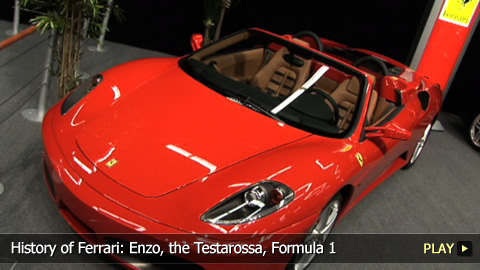History of Ferrari: Enzo, the Testarossa, Formula 1

Early Career of Enzo Ferrari
Ferrari cars began with one man: Enzo Ferrari. In 1920, he parlayed his lifelong passion for race cars into a career with Alfa Romeo. Nine years later, he started Scuderia Ferrari, which eventually proved successful as Alfa’s racing division.
Auto Avio Costruzioni
By the end of the 1930s, Ferrari left the company. He immediately started his own business, Auto Avio Costruzioni, in 1939. The first true Ferrari car was released the next year: the AAC 815.
The V12
During World War II, the company stalled. However, Ferrari survived the war and in 1945, he began tinkering with the versatile 12-cylinder engine.
Ferrari S.p.A.
Within two years, the V12 125 Sport was ready. Ultimately, it was this 12-cylinder engine that became synonymous with the brand. The 125 Sport established Ferrari as an important name in racing, and proved so successful that in 1947, Ferrari S.p.A. was founded.
Importance of Design
Ferrari then decided to unify the look of his cars. Enzo’s son Carlo took on the role of designer, and released the 166MM Barchetta in 1948. Styling then became an important part of the Ferrari brand, second only to performance. Famed Italian designer Batista Pinin Farina soon became an integral part of the Ferrari team.
Race Success
Ferrari’s endurance efforts at races like the Mille Miglia and Le Mans quickly became an important part of the Ferrari legend. In 1950, Ferrari began participating in Formula 1 by competing in the second-ever Grand Prix. The company’s dominance there increased sales of their road-worthy grand tourers.
The V6
In fact, sales more than tripled between 1950 and 1960. During that decade, Ferrari and his son Dino unveiled the V6 engine. When Dino died of muscular dystrophy in 1956, he became the namesake of those engines, and by the end of the 1960s Ferrari unveiled an entire Dino brand dedicated to cars with fewer than 12 cylinders.
Meeting with Ford
However, this was not before Ferrari met with the Ford Motor Company to discuss the possibility of a sale. Ford was aiming at a younger market segment with their 1963 offer of purchase, but talks collapsed when Enzo decided he wanted full control of racing operations.
Partnership with Fiat
As the 1970s approached, Ferrari struggled due to turmoil in Italy’s workforce and increasing environmental concerns. To combat this, Ferrari partnered with Fiat in 1969.
Formula 1
Efforts shifted mainly to F1 and away from endurance racing, and a number of key wins at the end of the decade justified this decision.
1973 Oil Crisis
However, 1973’s oil crisis meant luxury automakers were suffering. Ferrari succeeded with the introduction of the 308 GT4, which featured the company’s first production V8 engine and an extreme departure in design. Sales continued to increase on the strength of two-seater sports cars like the 308 GTB and GTS.
Increasing Sales
During the 1980s, Ferrari began to struggle on the race track, but saw unprecedented success with road models. In fact, in 1985, the company sold over three thousand cars for the first time, with help from the popular Testarossa.
Fortieth Anniversary
Mid-decade, Ferrari made collectors happy by releasing the limited edition 288 GTO. Brand recognition skyrocketed when a replica of a 1961 Ferrari 250 GT California was featured in the film “Ferris Bueller’s Day Off.” To celebrate the company’s fortieth anniversary, the F40 was released in 1987, and that model helped Ferrari sell more than four thousand cars the next year.
Death of Enzo Ferrari
However, that was Enzo Ferrari’s last project: he died August 14th, 1988. Following that, Ferrari suffered and Fiat became owner of 90 percent of the company.
Recent Years
Mid-decade, Michael Schumacher reinvigorated the team’s racing efforts. Majority ownership of the company continued to alternate in the years that followed, but nothing affected Ferrari’s passion for luxury.
Legacy
With excitement as its trademark, Ferrari continues pleasing loyal fans both on the road and on the race track with its unparalleled automotive masterpieces.
